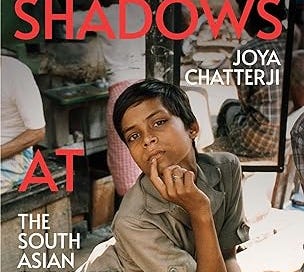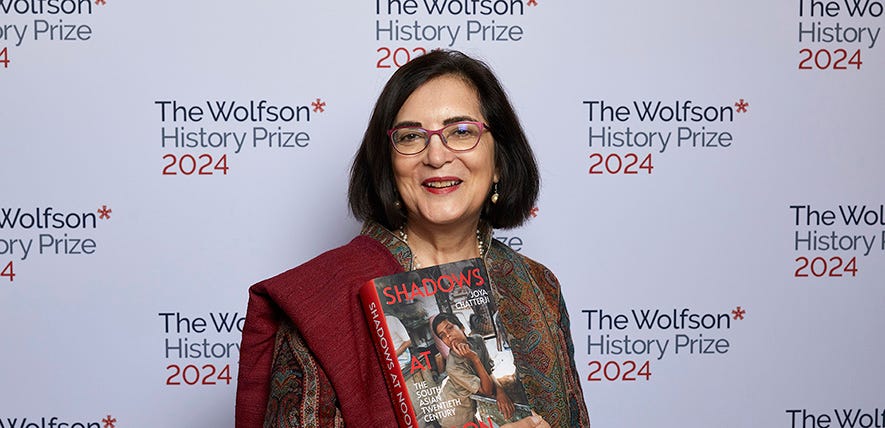The World Power World History Tour is going to India. This week’s post orients you to this fantastic journey, and the history book that will be our guide—Joya Chatterji, Shadows at Noon: The South Asian Twentieth Century.
Shadows at Noon is a prize-winning history of South Asia from the last decades of the British Raj through independence, partition, and the emergence of contemporary India, Pakistan, and Bangladesh.
Chatterji integrates discussion of India, Pakistan and Bangladesh (and to some degree Sri Lanka) whose stories are intertwined, despite the tragic Partitions of 1947 and 1971. Her work offers a new angle on world history since 1900. From the South Asian angle, the two world wars and the world of nations created by “post-war world order” are not the defining events. The questioning of Western nationhood by Rabindranath Tagore (1913 Nobel Prize winner), Gandhi and Nehru, the Amritsar Massacre in the shadows of the Peace of Versailles, and the tragic partitions of 1945 and 1971 loom larger in the South Asian historical imagination.
South Asia, too, was caught up in the world wars. It was the keystone in the arch of a global empire and many bloody tides of those wars washed over it. Yet the view from South Asia diverges so much from the standard understanding of the twentieth century that it demands our consideration - not least because divided India grew over that period from being one of the poorest places in the world to one of the wealthiest and most populous. Today one in six people on our planet is a South Asian; and the South Asian diaspora is the size of several countries. You will find its turning points are rather different from those of the ‘American century’.
Joya Chatterji, Shadows at Noon: The South Asian Twentieth Century, p. xviii
In this story, 1947 and its sequel in 1971 are more important turning points than the pair of 1945 and 1989. Chatterji writes that “The partition was a catastrophe of such magnitude that it is still difficult for me to comprehend how the rest of the world - even Britain - knew so little about it.” We will correct that ignorance over the course of the tour. Similarly, she writes the great event marking clashes of civilization, communal violence and terror was not the Twin Towers of 9/11, but the demolition of the Babri Mosque in 1992. Through Chatterji’s narrative, you will reimagine world history through South Asian eyes.
Unlike many histories that focus narrowly on political events and elite actors or grand civilizational themes, Chatterji’s work balances social, cultural, and personal dimensions—such as food, leisure, family life, and migration—with political narratives of nationalism and state-building.
The book aims to make contemporary South Asia intelligible, without underplaying its complexity. It does not attempt, in facile ways, to simplify the history of a vast, mythically intricate society. Yet it brings complicated processes in its modern history to life through the stories of people. Great men and women figure in it, as they must. But the stories of those on the wrong side of history, and on its margins find a place. Uncomfortable subjects that have fallen through the trapdoor of history re-emerge into the light.
Chatterji, Shadows at Noon, p. xix
The metaphor of the play of light and shadows is a leitmotif throughout the book. This metaphor challenges the entrenched narratives of black and white differences between India, Pakistan, and Bangladesh. Chatterji highlights instead the deep cultural and historical connections that bind the region’s people, and the many national, regional, political, linguistic, religious, and cultural identities which South Asians adopt and discard, like so many masks and shadow puppets.
“I seek to soar above a subcontinent partitioned by politics and states and observe with a bird’s eye its shifting patterns of light and shadows.”
Chatterji, Shadows at Noon, p. xxi
Chatterji’s writing is both scholarly and accessible, weaving together autobiography, family history, and the stories of those often left out of official histories. It is a stylistic contrast to the historical sociology of Klaus Mühlhahn, Making China Modern. This bird’s eye view of India is nothing like Mühlhahn’s helicopter view of institutions. It more closely resembles the constellation novel of Olga Tokarczuk. Chatterji’s tender narrator flies magically from great men and women to the untouchables; from Cabinet rooms to kitchen tables; from political tracts to Bollywood cinema; from the painful imperial partitions to romantic liaisons between an Englishwoman and a Dalit that tells a different tale to Forster’s A Passage to India.
It is also a counter-history to many claims that India is a coherent ‘civilization-state’, a term that I use conveniently and with some detachment on this world tour. There will be more discussion of that issue in later posts.
Joya Chatterji is Emeritus Professor of South Asian History at the University of Cambridge, Fellow of Trinity College, and a renowned expert on modern South Asia. Born in Delhi, she is acclaimed for her innovative histories and leadership in the field, including directing the Centre for South Asian Studies.
You can watch Joya Chatterji discuss Shadows at Noon at the Jaipur Literature Festival in 2024 here.
Program for India in World History Tour
Each week I will guide you through the key themes of this book, chapter-by-chapter.
I will be integrating the Wednesday deep dive and Saturday book recommendation posts into one, with the deep dive paywalled. This will mean you will receive less email, with one weekend post giving you a rich week’s worth of reading.
The deep dive will focus on one vivid story from Chatterji’s narrative that will deepen your insight into the play of light and shadow in South Asian history.
Here is the weekly program of posts (the chapter headings of Chatterji’s book if you would like to read along).
5 July, The Age of Nationalism: Competing Visions
12 July, Citizenship and Nation-building after Independence: South Asian experiences
19 July, The State in South Asia: A Biography
26 July, Migration at Home and Abroad: South Asian Diasporas
2 August, The Household, Marriage and the Family
9 August, Fasting, Feasting, Gluttony and Starvation: Consumption, Caste, and the Politics of Food in South Asia
16 August, Leisure, Twentieth-century Style
23 August, A Note on Further Viewing - Joya Chatterji’s guide to South Asian cinema!
Each week I will also make specific brief recommendations for other history books or cultural artefacts. I will keep those tips as surprises for now.
Reflections on the India-China relationship
As we shift our attention on this world tour from China to India, tensions between India and China have been in the news. They flared during the brief 2025 conflict between India and Pakistan, codenamed by India ‘Operation Sindoor,’ that followed a terrorist incident that was likely linked to Pakistani sponsors. Pakistan deployed Chinese weaponry against India. Claims and counter-claims about the success of Chinese or Indian arms have consumed many hours since on YouTube.
However, this incident went against the general trends since 2020 of an easing of tensions between India and China in a diplomatic rapprochement. The relationship between the two most populous countries of the world is of profound importance. The current Indian External Affairs Minister, Dr S. Jaishankar, wrote in The India Way that:
“The ability of India and China to work together could determine the Asian century. Equally, their difficulties in doing so may well undermine it.”
Dr S. Jaishankar, The India Way
Western analysts will often frame this relationship against a narrative of the West versus the Rest. Will India choose the USA side? Will India betray its BRICS partners? Does China’s socialist model show up India’s late emulation of the Western liberal path of social and economic development?
But this framing of the issue is distorted. China and India have millennia of shared history. The decades of conflict since 1949, and especially 1962, are overlaid on centuries of pluralistic, dialogic, mutual enrichment. China and India do not need Donald Trump or Vladimir Putin or Emmanuel Macron to sort out their squabbles. The Asian sisters are doing it for themselves. I share some thoughts on the relationship in this week’s deep dive for paid subscribers.
Catch-up on this Week’s Writing and Videos
But first, here is your guide to catching up on my content over the last week.
The Slow Read of The Books of Jacob reached the climax of the novel, the death of Jacob Frank. We met Eva Frank, who succeeded Jacob as a claimant Messiah, even though surrounded by total strangers.
The replay of the China in the World Workshop came out on Wednesday (for paid subscribers).
My video on the history of NATO - Historian DESTROYS lies about NATO'S 'defensive alliance' as the G.O.A.T. - explored common myths and better insights. It is timely with the NATO Summit this week appearing to entrench Europe into a militarised base of American operations against the rest of Eurasia.
I also discussed this issue with Jamarl Thomas here.
I released the next in my series of Letters to Americans and Empire Endgame - How to undo the USA empire, SLOWLY.
I also produced a video, Stay Sane in a Mad World that outlines my new paid workshop. Do you want to stay sane while the world is in crisis and at war? History can help. I will show you how in my new workshop.
Many thanks to all my subscribers, paid and unpaid, for supporting me in this fantastic journey through history. I hope it helps you to live in tune with a changing world. Please consider upgrading your subscription to get more from my guides, deep dives, and slow reads.
Below the paywall, a deep dive on the India-China relationship
I expand on a Chinese and Indian view of this key relationship below in my deep dive introduction to the Indian leg of the World Powers World History Tour.





